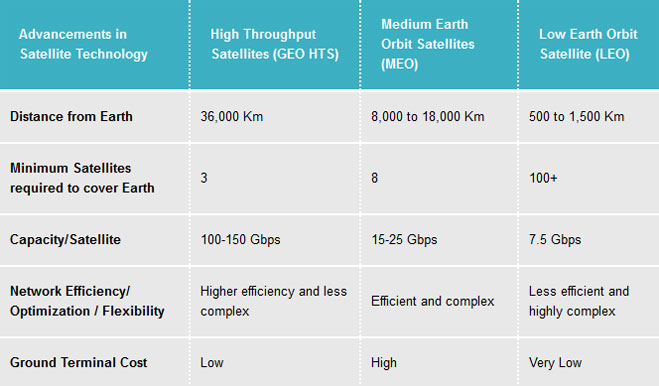News

The Indian satellite space is on the cusp of a revolution. Newer, disruptive technologies are changing the face of satellite communication with optimal performance, better efficiency and lower bandwidth cost. This is achieved by high level frequency re-use and spot beam technology. It can be said without a doubt that these advancements have the potential to transform the VSAT space across the globe.
A particular advancement that is bringing in a revolution is High Throughput Satellite (HTS).
While traditional GEO (Geostationary) satellites have been around for a few decades, GEO HTS will be responsible for a transformation of the satellite communication industry in the near future.

GEO HTS satellites are far more powerful than traditional satellites. While we need more than 100 LEO satellites to cover Earth, only 3 GEO HTS satellites are enough to reach every nook and corner of the planet. What makes this even more interesting is that GEO HTS are a whopping 36000 kms away from Earth. In comparison, LEOs (Low Earth Orbit Satellites) are 500 to 1500 kms away and MEOs (Medium Earth Orbit Satellites) are 8000 to 18000 kms from the planet.
You may think so few satellites so far away could not possibly deliver the speed needed for modern day communication requirements. The speed is actually what makes GEO HTS satellites the communication unicorn. It can provide a capacity of 100-150 GBPS per satellite. On the other hand, capacity per satellite of MEOs are 15-25 GBPS and LEOs are 7.5 GBPS.

The ground terminal size and cost is lesser than that of MEOs. While MEO antenna size is approximately 2.4M, that of a GEO HTS is 1M. This makes it compact and a lot easier to deploy. Also, it is cost effective as the cost of GEO HTS is much lower than MEOs. On the other hand, LEO antennas are less expected to be cheaper than 1M the current 1M antenna (once they are produced in bulk)and cheaper than GEO HTS, but the other benefits far outweigh this difference.


More than the cost and ease of implementation, what makes any communication technology a true differentiator is the network efficiency it can provide. A GEO HTS has higher efficiency than any other satellite technology. It has in-built optimization capabilities to ensure top performance. What more, the technology is robust, flexible and scalable. It can adapt to changing business needs to best suit current requirements. It enables all this minus the complexity of a MEO or LEO satellite.
This revolutionary technology is ideal for the energy sector, mining, aerospace, maritime and connecting rural India, among other industries.
While we have established that HTS GEO has the potential to disrupt the satellite communication space, there are few cons we should be aware of.
The total capacity of HTS GEO remains the same as capacity per satellite at 100-150 GBPS. However, the total capacity of other satellite constellation types increases exponentially at 200-300 GBPS for MEOs and 5-10 TBPS for LEOs. However, this is just total aggregated bandwidth of the satellite constellation; in isolation on a per satellite bandwidth, GEO HTS scores over others. Another con is the latency. Latency for HTS GEO can be up to 600 ms as opposed to MEO’s 150 ms and LEO’s 50 ms.


The ground terminal size and cost is lesser than that of MEOs. While MEO antenna size is approximately 2.4M, that of a GEO HTS is 1M. This makes it compact and a lot easier to deploy. Also, it is cost effective as the cost of GEO HTS is much lower than MEOs. On the other hand, LEO antennas are less expected to be cheaper than 1M the current 1M antenna (once they are produced in bulk)and cheaper than GEO HTS, but the other benefits far outweigh this difference.